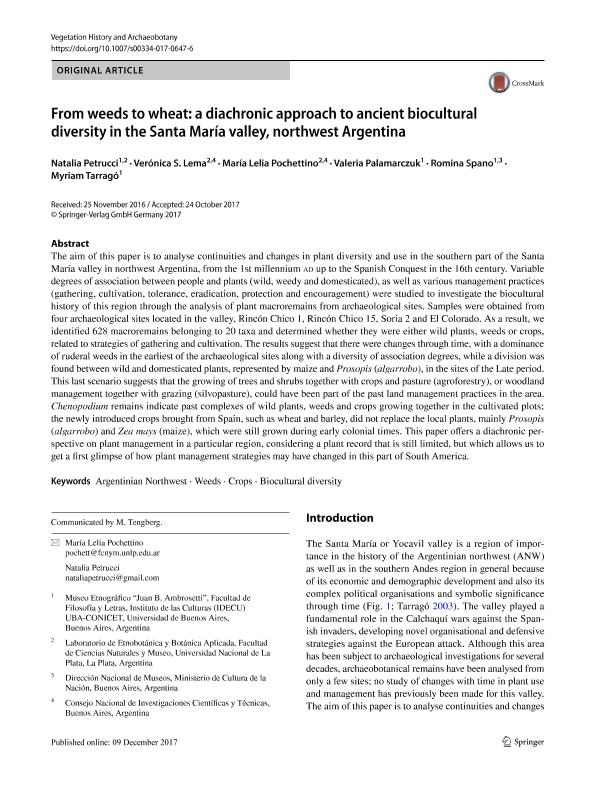Artículo
From weeds to wheat: a diachronic approach to ancient biocultural diversity in the Santa María valley, northwest Argentina
Petrucci, Natalia Silvana; Lema, Veronica Soledad ; Pochettino, María Lelia
; Pochettino, María Lelia ; Palamarczuk, Valeria
; Palamarczuk, Valeria ; Spano, Romina Clara
; Spano, Romina Clara ; Tarrago, Myriam Noemi
; Tarrago, Myriam Noemi
 ; Pochettino, María Lelia
; Pochettino, María Lelia ; Palamarczuk, Valeria
; Palamarczuk, Valeria ; Spano, Romina Clara
; Spano, Romina Clara ; Tarrago, Myriam Noemi
; Tarrago, Myriam Noemi
Fecha de publicación:
01/2018
Editorial:
Springer
Revista:
Vegetation History And Archaeobotany
ISSN:
0939-6314
Idioma:
Inglés
Tipo de recurso:
Artículo publicado
Clasificación temática:
Resumen
The aim of this paper is to analyse continuities and changes in plant diversity and use in the southern part of the Santa María valley in northwest Argentina, from the 1st millennium ad up to the Spanish Conquest in the 16th century. Variable degrees of association between people and plants (wild, weedy and domesticated), as well as various management practices (gathering, cultivation, tolerance, eradication, protection and encouragement) were studied to investigate the biocultural history of this region through the analysis of plant macroremains from archaeological sites. Samples were obtained from four archaeological sites located in the valley, Rincón Chico 1, Rincón Chico 15, Soria 2 and El Colorado. As a result, we identified 628 macroremains belonging to 20 taxa and determined whether they were either wild plants, weeds or crops, related to strategies of gathering and cultivation. The results suggest that there were changes through time, with a dominance of ruderal weeds in the earliest of the archaeological sites along with a diversity of association degrees, while a division was found between wild and domesticated plants, represented by maize and Prosopis (algarrobo), in the sites of the Late period. This last scenario suggests that the growing of trees and shrubs together with crops and pasture (agroforestry), or woodland management together with grazing (silvopasture), could have been part of the past land management practices in the area. Chenopodium remains indicate past complexes of wild plants, weeds and crops growing together in the cultivated plots; the newly introduced crops brought from Spain, such as wheat and barley, did not replace the local plants, mainly Prosopis (algarrobo) and Zea mays (maize), which were still grown during early colonial times. This paper offers a diachronic perspective on plant management in a particular region, considering a plant record that is still limited, but which allows us to get a first glimpse of how plant management strategies may have changed in this part of South America.
Palabras clave:
Argentinian Northwest
,
Biocultural Diversity
,
Crops
,
Weeds
Archivos asociados
Licencia
Identificadores
Colecciones
Articulos(IDECU)
Articulos de INSTITUTO DE LAS CULTURAS
Articulos de INSTITUTO DE LAS CULTURAS
Citación
Petrucci, Natalia Silvana; Lema, Veronica Soledad; Pochettino, María Lelia; Palamarczuk, Valeria; Spano, Romina Clara; et al.; From weeds to wheat: a diachronic approach to ancient biocultural diversity in the Santa María valley, northwest Argentina; Springer; Vegetation History And Archaeobotany; 27; 1; 1-2018; 229-239
Compartir
Altmétricas



